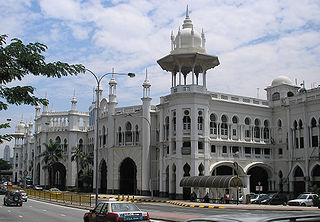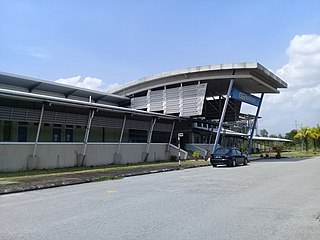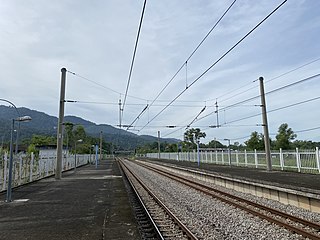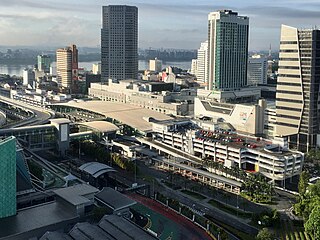Keretapi Tanah Melayu Berhad (KTMB) or Malayan Railways Limited, colloquially referred to simply as KTM, is the main rail operator in Peninsular Malaysia. The railway system dates back to the British colonial era, when it was first built to transport tin. Previously known as the Federated Malay States Railways (FMSR) and the Malayan Railway Administration (MRA), Keretapi Tanah Melayu acquired its current name in 1962. The organisation was corporatised in 1992, but remains wholly owned by the Malaysian government.

Indo-Saracenic architecture was a revivalist architectural style mostly used by British architects in India in the later 19th century, especially in public and government buildings in the British Raj, and the palaces of rulers of the princely states. It drew stylistic and decorative elements from native Indo-Islamic architecture, especially Mughal architecture, which the British regarded as the classic Indian style. The basic layout and structure of the buildings tended to be close to that used in contemporary buildings in other revivalist styles, such as Gothic revival and Neo-Classical, with specific Indian features and decoration added.

KTM Komuter is a commuter rail system in Malaysia operated by Keretapi Tanah Melayu (KTM). It was introduced in 1995 to provide local rail services in Kuala Lumpur and the surrounding Klang Valley suburban areas. Services were later expanded to other parts of Malaysia with the introduction of the Northern and Southern sectors.

The Kuala Lumpur railway station is a railway station located in Kuala Lumpur, Malaysia. Construction began in 1910 and was fully completed in 1917. It replaced an older station on the same site, the station was Kuala Lumpur's railway hub in the city for the Federated Malay States Railways and its successor Keretapi Tanah Melayu, before Kuala Lumpur Sentral assumed much of its role in 2001. The station is notable for its architecture, adopting a mixture of Eastern and Western designs.

The Ubudiah Mosque is a small mosque located in the royal town of Kuala Kangsar, Perak, Malaysia.

The Serendah Komuter station is a Malaysian commuter train station stationed roughly two kilometres northwest from the town of Serendah, Selangor. The station is located on the KTM West Coast Line.

Edwardian architecture usually means a Neo-Baroque architectural style that was popular for public buildings in the British Empire during the Edwardian era (1901–1910). Architecture up to the year 1914 is also commonoly included in this style.

The Tanjung Malim railway station is a Malaysian train station stationed at the north eastern side of and named after the town of Tanjung Malim, Perak. The station provides both Komuter and ETS services.
The Federated Malay States Railways (FMSR) was a consolidated railway operator in British Malaya during the first half of the 20th century. Named after the then recently formed Federated Malay States in 1896 and founded five years after the formation of the federation, the company acquired various railways that were developed separately in various parts of Malaya, and oversaw the largest expansion and integration of the colonial rail network encompassing the Federated Malay States, the Unfederated Malay States and the Straits Settlements, with lines spanning from Singapore in the south to Padang Besar in the north.

The Slim River railway station is a Malaysian train station stationed at the north eastern side of and named after the town of Slim River, Muallim District, Perak.

The Sungkai railway station is a Malaysian train station stationed at the north eastern side of and named after the town of Sungkai, Perak, Malaysia.
The Tapah Road railway station is a Malaysian railway station stationed at the north eastern side of and named after the town of Tapah Road, Perak. The station is owned by Keretapi Tanah Melayu and provides KTM ETS services. At one end of this station, there is a freight yard. It was made prior to the Rawang-Ipoh Electrified Double Tracking Project.

The Kampar railway station is a Malaysia train station located and named after the town of Kampar, Perak.
The Kota Bharu railway station is a Malaysian train station stationed at the north eastern side of and named after the town of Kota Bharu, Perak. But prior to the Rawang–Ipoh Electrified Double Tracking project, the station has turned into a freight yard. So, people who stay in Kota Bharu will no longer get the passenger services. The nearest passenger station is the Batu Gajah railway station.

Railway electrification in Malaysia is a relatively recent development of rail transport in Malaysia. While the first railway in the country dates back to 1885, it was not until 3 August 1995 that the first electrified railway service, KTM Komuter, began operations.

The Behrang railway station is a Malaysian train station stationed at the south-eastern side of and named after the town of Behrang, Perak. The station was reopened and electrified in 2007. At one end of this station, there is a freight yard. It was made prior to the Rawang-Ipoh Electrified Double Tracking Project. Currently, this station is not in used as the ETS railway service does not stop here.

Johor Bahru Sentral is an integrated transport hub in Bukit Chagar, Johor Bahru, Johor, Malaysia.
The Lahat railway station is a Malaysian train station on the northeastern side of and named after the town of Lahat, Kinta District, Perak, although prior to the Rawang-Ipoh Electrified Double Tracking project, the station has been converted into a freight yard. People living in Lahat will no longer get passenger services. The nearest passenger station is the Batu Gajah railway station.

Arthur Benison Hubback was an English architect and soldier who designed several important buildings in British Malaya, in both Indo-Saracenic architecture and European "Wrenaissance" styles. Major works credited to him include Kuala Lumpur railway station, Ubudiah Mosque, Jamek Mosque, National Textile Museum, Panggung Bandaraya DBKL, Ipoh railway station, and Kowloon railway station.

The National Textile Museum is a museum in Kuala Lumpur, Malaysia. The museum is open daily from 9 am to 6 pm, with admission fees ranging from RM2 to RM5.

















